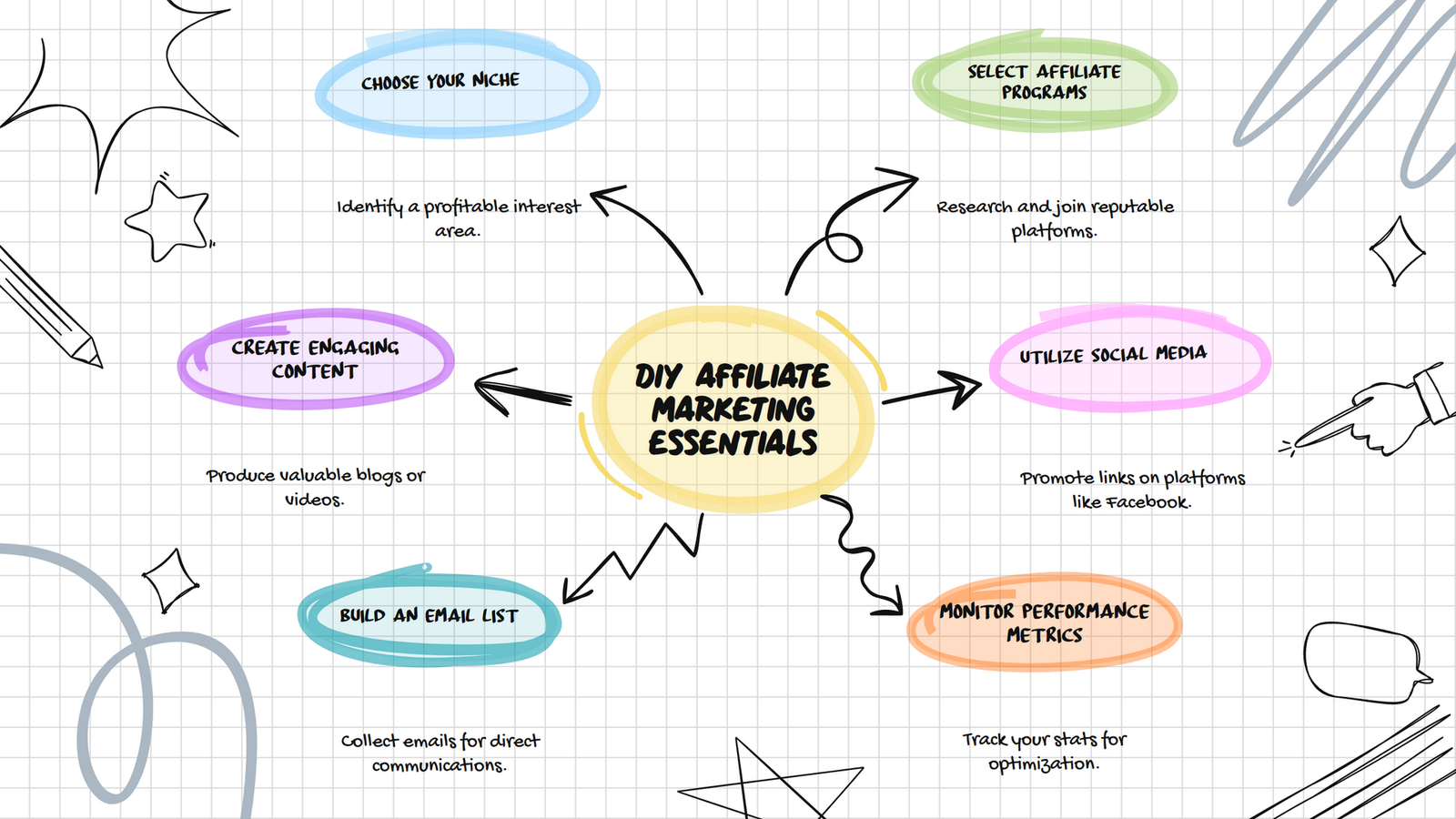Many aspiring marketers are exploring DIY affiliate marketing as a way to generate passive income without a hefty upfront investment. By choosing the right affiliate programs and focusing on engaging content creation, you can effectively promote products and earn commissions without breaking the bank. This guide will walk you through budget-friendly strategies, crucial tools, and the importance of niche selection to help you build a successful affiliate marketing venture from the ground up.
Laying the Groundwork for Success
To kick off your affiliate marketing journey, it’s essential to grasp the basics and equip yourself with the right tools. Understanding your niche is critical. Your niche defines the audience you’ll connect with and the products you’ll promote. Focus on a specific area where you can provide value and build trust.
But knowledge alone isn’t enough. You need guidance. That’s where our Free Master Affiliate Profits Membership comes in. This training hub is packed with resources and insights from seasoned marketers. It’s designed to elevate your skills and sharpen your strategies, all without stretching your budget.
Let’s dive deeper. In the sections ahead, we’ll explore practical strategies for selecting affiliate programs, creating compelling content, and leveraging the right tools. This isn’t just about theory; it’s about actionable steps to get you started and keep you moving forward. So, buckle up. Your path to affiliate marketing success starts now.

Types of Affiliate Marketing
Before venturing into affiliate marketing, it’s vital to understand the various models available to you. Each type offers unique ways to earn based on how products or services are promoted:
| Pay-per-sale (PPS) | You earn a commission when a referred customer makes a purchase. |
| Pay-per-click (PPC) | You earn money for every click on your affiliate link, regardless of a sale. |
| Pay-per-lead (PPL) | You earn a commission when a referred customer signs up for a service or fills out a form. |
| Cost-per-action (CPA) | You earn a commission when a user completes a specified action, like signing up for a newsletter. |
| Recurring commissions | You earn ongoing commissions for subscription services. |
Thou will find that choosing the right model is imperative to your affiliate marketing success.
Pay-per-sale (PPS)
With this model, you earn a commission for every sale made through your affiliate link. This means you’ll need to drive significant traffic and make compelling content to encourage purchases. By leveraging social media or a blog, you can effectively promote products and maximize your earnings.
Pay-per-click (PPC)
To generate income through PPC, you earn money simply for the clicks on your affiliate links, irrespective of whether a sale occurs. This model allows you to monetize your traffic more flexibly and is ideal for those just starting who may not have the means to directly influence sales.
It is important to approach PPC cautiously. While it can yield quick earnings, you must be aware of your link placement and audience engagement, as poorly targeted ads can lead to low conversion rates. Balance your strategies with valuable content to maximize potential profits while minimizing wasted efforts. This way, you can optimize your earnings without breaking your budget.
Step-by-Step Guide to Getting Started
One of the best ways to launch on your DIY affiliate marketing journey is to follow a structured approach. Start by determining your niche, select suitable affiliate programs, create engaging content, and then promote your links across various platforms. This step-by-step guide will pave the way for building your affiliate marketing strategy effectively.
Steps to Get Started
| 1. Choose Your Niche | Identify a specific area of interest that resonates with you and has profit potential. |
| 2. Select Affiliate Programs | Research and choose programs that align with your niche and offer competitive commissions. |
| 3. Create Content | Develop valuable content like blogs or videos that incorporate your affiliate links. |
| 4. Promote Your Links | Utilize social media, email lists, and free platforms to drive traffic to your content. |
Choose Your Niche
For successful affiliate marketing, you must choose a niche that not only interests you but also has a strong audience demand. By focusing your efforts on a specific topic, you can create content that speaks directly to your target audience, thereby building trust and increasing conversion rates. Researching market trends and popular categories can help you pinpoint the right niche to pursue.
Select Affiliate Programs
One of the foundational steps is to select the right affiliate programs that fit your niche. Look for programs that offer generous commissions and don’t require an established audience. Platforms like Amazon Associates and ShareASale are excellent starting points, as they cater to beginners and provide a wide array of products for promotion.
StepbyStep, effective selection of affiliate programs can be transformative. Evaluate each program for commission rates, payment methods, and the credibility of the products. Be wary of programs with unreasonably high fees or those lacking transparency, as they could hinder your efforts and growth. Prioritize programs with a solid reputation, as these can significantly boost your credibility and provide stable income opportunities, enhancing your DIY affiliate marketing experience.

Budget-Friendly Promotion Strategies
Assuming you’re starting your affiliate marketing journey on a budget, you’ll want to explore various budget-friendly promotion strategies. Utilizing free platforms and tools will enable you to reach a broader audience without hefty expenses. Focus on creating engaging content that resonates with your target market, and you’ll be well on your way to generating traffic and conversions, all while keeping costs to a minimum.
Utilizing Social Media
If you’re looking to promote your affiliate links effectively, leverage social media platforms like Pinterest, TikTok, and Instagram. These channels allow you to create visually appealing posts and share valuable content, attracting potential customers without requiring upfront costs. Engaging with your audience through regular updates can boost your visibility and encourage shares, increasing your chances of earning commissions.
Leveraging Content Marketing
Assuming you’ve found your niche, you can use content marketing to enhance your affiliate marketing efforts significantly. The best way to connect with your audience is through valuable, informative content like blog posts, video tutorials, and how-to guides. This approach not only builds trust but also positions you as an authority in your niche. By focusing on quality content that addresses your audience’s needs, you can drive more traffic to your affiliate links and ultimately increase your earnings. With free platforms like Medium and blogging sites, you can share your insights without spending a dime, making content marketing a powerful ally in your DIY affiliate journey. Always monitor your results to refine your approach, ensuring that your efforts yield the best returns available.

Essential Tips for Success
Unlike traditional marketing, DIY affiliate marketing flourishes with the right approach. To ensure success, focus on these necessarys:
- Choose the right affiliate programs that provide high commissions.
- Create targeted content that resonates with your audience.
- Utilize cost-effective tools to enhance your strategy.
- Regularly monitor your performance metrics.
Recognizing these tips can transform your affiliate journey into a profitable endeavor.
Creating Engaging Content
Success in affiliate marketing largely hinges on your ability to create engaging content that captivates your audience. This content should not only inform but also encourage them to take action through your affiliate links. Utilize storytelling, visuals, and clear calls-to-action to enhance engagement and spur conversions.
Building an Email List
The foundation of a successful affiliate marketing strategy lies in building an email list. By collecting email addresses, you gain direct access to your audience and can foster a loyal community interested in your content and promotions. Email marketing offers one of the highest ROI in digital marketing, making it an necessary component.
Another important aspect of building an email list is nurturing your subscribers. Use compelling lead magnets like free guides or exclusive discounts to encourage sign-ups. As you maintain consistent communication with your list, you foster trust and set the stage for higher conversions. However, be cautious about overwhelming your audience; balance promotional content with valuable insights to keep them engaged.

Factors Influencing Affiliate Marketing Success
To achieve success in affiliate marketing, several factors can significantly impact your results:
- Niche selection determines your target audience.
- Content quality drives engagement and trust.
- Traffic sources affect your reach and visibility.
- Audience engagement fosters loyalty and repeat visits.
Perceiving these factors will guide you in effectively building your affiliate marketing strategy. For more insights, check out How I Make Money ($150k/year) With Affiliate Marketing.
Audience Engagement
Engagement is vital in building a loyal audience that trusts your recommendations. To enhance engagement, focus on adding value through informative and relatable content. Encourage interactions through comments or polls, and respond promptly to queries. The more connected your audience feels, the higher the likelihood they’ll click on your affiliate links.
Conversion Rate Optimization
Factors affecting conversion rates include the clarity of your calls to action, the layout of your landing pages, and the relevance of your content. Enhancing these aspects can drive more clicks and result in sales.
With effective conversion rate optimization, you can increase the likelihood that your visitors will take the desired action, whether that’s clicking on a link or making a purchase. Focus on using compelling CTAs and creating a seamless user experience. Note, conducting A/B tests on different elements can reveal what resonates best with your audience, helping you refine your approach for maximum impact.
Pros and Cons of DIY Affiliate Marketing
Keep in mind that DIY affiliate marketing has its ups and downs. Understanding these pros and cons will help you evaluate whether it aligns with your goals and capabilities.
| Pros | Cons |
|---|---|
| Low startup costs | Time-consuming to create content |
| Accessibility of affiliate programs | Potential for less stability in earnings |
| Flexibility in marketing strategies | High competition in popular niches |
| Independence in decision-making | Limited resources for advanced tools |
| Opportunity for creativity | Learning curve for performance tracking |
Advantages
Even with a shoestring budget, you can engage in DIY affiliate marketing to carve out a passive income stream. The minimal investment required means you can dive in without financial risk, making it accessible for anyone willing to put in the effort. The flexibility to choose your niche and create personalized content allows you to maintain a sense of ownership over your marketing strategies, enhancing your creativity and engagement.
Challenges
Marketing yourself can be rewarding, but it comes with its own set of challenges. You may initially struggle with generating traffic as you build your audience from scratch. With affiliate marketing, you also face the reality of fluctuating income; it often takes time to see significant results. Learning to track performance effectively can be overwhelming without prior experience, and finding the right niche may prove difficult in a saturated market.
Pros and cons will shape your experience in DIY affiliate marketing. While the low investment is a positive aspect, be cautious of the time and effort required to succeed. With dedication, you can create engaging content and optimize your campaigns, but monitoring competition and adjusting your strategies according to your findings is vital. Understanding these challenges upfront will empower you to navigate the landscape more effectively.
Key Takeaways
- Understanding Your Niche is Crucial: Defining a specific niche helps you connect with your target audience and strengthens your brand.
- Choose the Right Affiliate Programs: Selecting programs with high commissions and reputable products can significantly impact your earnings.
- Engage Through Quality Content: Creating valuable, informative, and engaging content is essential for driving traffic and conversions.
- Utilize Cost-Effective Promotion Strategies: Free platforms and social media are powerful tools to promote your affiliate links without straining your budget.
- Build and Nurture Your Email List: An email list allows you to maintain direct communication with your audience, fostering loyalty and boosting conversions over time.
Conclusion
In summary, navigating the world of DIY affiliate marketing on a budget is not only possible but also a promising avenue for financial growth. By honing in on your niche and selecting the right affiliate programs, you can create meaningful connections through engaging content. Combine this with strategic promotion using free tools, and you’re well on your way to crafting a successful affiliate marketing journey. Remember, every step you take brings you closer to that rewarding income stream you envision.
Now, imagine waking up each day, knowing your efforts are steadily building a passive income. Visualize the freedom to work on your terms, with an engaged audience and flourishing affiliate partnerships. The road ahead is filled with opportunities waiting for you to seize; all you need to do is take that next step.
Curious about how to unlock the secrets of successful affiliate marketing?
There’s so much more to explore that just scratches the surface here. We invite you to dive deeper and discover the Free Master Affiliate Profits Membership—a treasure trove of insights and exclusive training designed to elevate your affiliate marketing game. Don’t let curiosity linger; click through to find the tools and strategies that will transform your aspirations into reality. The next chapter in your affiliate marketing journey is just a click away—are you ready to write it?
FAQs
- What is DIY affiliate marketing? DIY affiliate marketing involves promoting products or services through affiliate links and earning commissions on sales or leads generated, all while managing the process independently, often on a budget.
- How do I choose a profitable niche? To choose a profitable niche, consider your interests, research market demand, analyze trends, and evaluate competition to find an area where you can provide unique value.
- What are some effective ways to promote affiliate links? Effective promotion strategies include using social media platforms, writing engaging blog posts, creating informative videos, and leveraging email marketing to reach your audience.
- How important is content quality in affiliate marketing? Content quality is vital as it builds trust, engages your audience, and encourages them to click your affiliate links, ultimately influencing conversion rates.
- What tools can I use to track my affiliate marketing performance? You can use tools like Google Analytics, affiliate dashboards provided by networks, and specialized tracking software to monitor traffic, clicks, and conversions effectively.
Recent Posts
Affiliate Offer Goldmine: How I Find Profitable Affiliate Offers
Affiliate marketing can be overwhelming if you rely on guesswork or follow generic advice. I've discovered that most beginners waste time promoting overcrowded, untested, or unprofitable offers. In...
As an affiliate marketer, you know how crucial it is to create engaging and effective blog posts that drive traffic and generate sales. But coming up with fresh and profitable ideas can be a...

